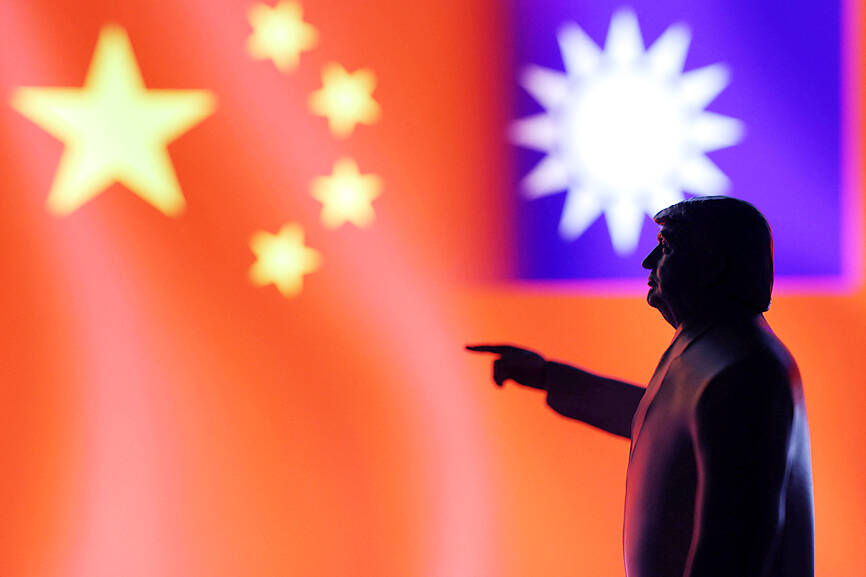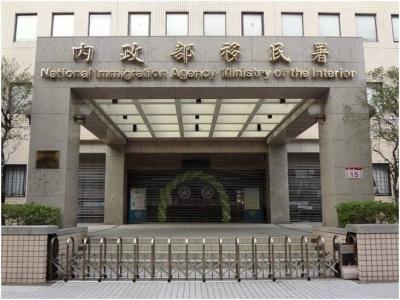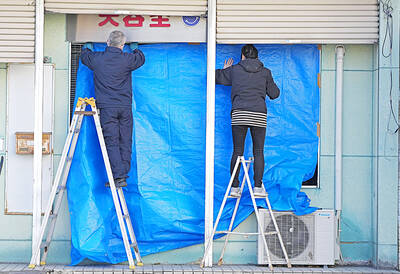A former White House official on Sunday said he does not believe US President Donald Trump would ever use Taiwan as a bargaining chip in dealings with Chinese President Xi Jinping (習近平).
“Taiwan has been a core national interest of the United States. Taiwan’s autonomy and sovereignty have been a core interest of ours for decades,” said Alexander Gray, who served as deputy assistant to the president and chief of staff of the National Security Council during Trump’s first term.
“I don’t see any reason why President Trump would ever, for the first time in his eight years as president, compromise on a core interest of the United States,” he said in an interview with the Central News Agency.

Photo: Reuters
However, he expressed concern that due to domestic politics, Taiwan has not demonstrated sufficient resolve to raise its defense spending.
Although he believes that Taiwan is moving in the right direction with its defense reforms, Gray said the scale of Taipei’s planned budget increases remains inadequate given the magnitude of the threat from China.
For this year, the Cabinet allocated NT$647 billion (US$21.52 billion) for defense, equal to 2.45 percent of GDP. President William Lai (賴清德) has repeatedly pledged to raise that figure above 3 percent of GDP.
Gray recently visited Taiwan and spoke at the annual Ketagalan Forum: Indo-Pacific Security Dialogue in Taipei earlier this month.
Asked about some of the topics raised during his visit, Gray said that many of his conversations in Taiwan centered on complaints about Trump’s trade policy.
However, he said that such concerns overlook a deeper shift in Washington’s stance.
“This [higher tariff] is not going to change, and I don’t think the next president, Republican or Democrat, is going to change it either,” he said.
“That’s a new reality that we have to face ... and if we keep arguing the premise, we’re wasting time and we’re distracting ourselves,” he added.
Trump has made it clear that he views trade policy “as separate from strategic policy,” he said. “He [Trump] thinks we can have a great strategic relationship while having very real concerns about a country’s trade policy.”
Gray, who served on the 2016 presidential transition team at the US Department of State, said that during Trump’s first term, the president had sought to impose higher tariffs on several countries, but was blocked by his secretary of defense, secretary of state and national security adviser, who raised concerns about damaging strategic partnerships.
“None of that’s happening anymore, because there’s an understanding in this administration that these are two separate issues,” Gray said, adding that Taiwan should adapt to this new reality.
He suggested that Taipei could appeal to Trump on bilateral trade by boosting investment in the US and committing to projects that “create jobs,” thereby strengthening its case for lower tariffs.
The US on Aug. 7 imposed a baseline 20 percent tariff on Taiwanese goods, higher than the 15 percent levied on imports from Japan and South Korea, raising concern about the impact on Taiwan’s economy.
After the announcement, Lai said Washington remained open to further tariff discussions, adding that the two sides have yet to finalize a trade deal and calling the tariff “provisional.”

A small number of Taiwanese this year lost their citizenship rights after traveling in China and obtaining a one-time Chinese passport to cross the border into Russia, a source said today. The people signed up through Chinese travel agencies for tours of neighboring Russia with companies claiming they could obtain Russian visas and fast-track border clearance, the source said on condition of anonymity. The travelers were actually issued one-time-use Chinese passports, they said. Taiwanese are prohibited from holding a Chinese passport or household registration. If found to have a Chinese ID, they may lose their resident status under Article 9-1

Taiwanese were praised for their composure after a video filmed by Taiwanese tourists capturing the moment a magnitude 7.5 earthquake struck Japan’s Aomori Prefecture went viral on social media. The video shows a hotel room shaking violently amid Monday’s quake, with objects falling to the ground. Two Taiwanese began filming with their mobile phones, while two others held the sides of a TV to prevent it from falling. When the shaking stopped, the pair calmly took down the TV and laid it flat on a tatami mat, the video shows. The video also captured the group talking about the safety of their companions bathing

A classified Pentagon-produced, multiyear assessment — the Overmatch brief — highlighted unreported Chinese capabilities to destroy US military assets and identified US supply chain choke points, painting a disturbing picture of waning US military might, a New York Times editorial published on Monday said. US Secretary of Defense Pete Hegseth’s comments in November last year that “we lose every time” in Pentagon-conducted war games pitting the US against China further highlighted the uncertainty about the US’ capability to intervene in the event of a Chinese invasion of Taiwan. “It shows the Pentagon’s overreliance on expensive, vulnerable weapons as adversaries field cheap, technologically

Starting on Jan. 1, YouBike riders must have insurance to use the service, and a six-month trial of NT$5 coupons under certain conditions would be implemented to balance bike shortages, a joint statement from transportation departments across Taipei, New Taipei City and Taoyuan announced yesterday. The rental bike system operator said that coupons would be offered to riders to rent bikes from full stations, for riders who take out an electric-assisted bike from a full station, and for riders who return a bike to an empty station. All riders with YouBike accounts are automatically eligible for the program, and each membership account